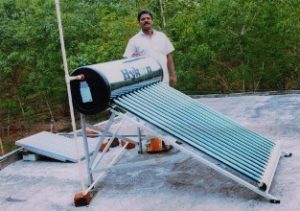India: NABARD to offer Subsidy for Solar Water Heaters
October 4, 2011
Logo NABARD
 In its Circular No.147 /ICD- 36 /2011 dated 3 August 2011, the Indian National Bank for Agriculture and Rural Development (NABARD) has included solar water heating systems as an eligible technology for subsidy and low-interest loans if they do not exceed a capacity of 400 litres. The circular is addressed to all commercial banks and regional/rural banks involved. An earlier circular – No.110 dated 27 May 2011 – had already announced the Capital Subsidy-cum-Refinance Scheme for decentralised solar PV installations.
In its Circular No.147 /ICD- 36 /2011 dated 3 August 2011, the Indian National Bank for Agriculture and Rural Development (NABARD) has included solar water heating systems as an eligible technology for subsidy and low-interest loans if they do not exceed a capacity of 400 litres. The circular is addressed to all commercial banks and regional/rural banks involved. An earlier circular – No.110 dated 27 May 2011 – had already announced the Capital Subsidy-cum-Refinance Scheme for decentralised solar PV installations.
It is an important step towards reaching the rural Indian population with the national solar subsidy scheme of the Indian Ministry of New and Renewable Energy. Most of the MNRE-approved channel partners are located in urban areas. They may not find it particularly interesting to do business in semi-urban and rural areas, in which 70 % of the population in India live. The National Bank for Agriculture and Rural Development has the largest number of associated rural banks worldwide.
System with both collector technologies – flat plate and vacuum tube – will be eligible for either subsidies or subsidised bank loans. Technical requirements are:
- Minimum capacity of 100 litres per day at 60 °C
- 2 m2 for a system of 100 litres capacity
- Capacity of domestic system between 100 litres and 400 litres
The client has the choice between a 30 % subsidy on the benchmark costs or a low-interest loan (5 % interest rate) for 80 % of the benchmark costs. Low-interest loans and subsidies cannot be combined. The following tables show how customers are supported, depending on the technology used, as well as on the region. The Special Category States include Himachal Pradesh, Uttarakhand, Jammu & Kashmir and the North Eastern States:
| Eligible Sector, Technology and Region | Benchmark Cost(per unit) | Subsidy (rate and total) | OR | Bank Loan (5 % interest rate) |
| Users of flat plate collectors in all states other than the Special Category States | INR 22,000- | 30 % – INR 6,600 | OR | 80 % unit cost INR 17,600/- |
| Domestic and institutional users of flat plate collectors in Special Category States | INR 22,000- | 60 % – INR 13,200 | OR | 80 % unit cost INR 17,600/- |
| Commercial users of flat plate collectors in Special Category States | INR 22,000- | 30 % – INR 6,600 | OR | 80 % unit cost INR 17,600/- |
| Users of vacuum tube collectors in all states other than the Special Category States | INR 20,000- | 30 % – INR 6,000 | OR | 80 % unit cost INR 16,000/- |
| Domestic and institutional users of vacuum tube collectors in Special Category States | INR 20,000- | 60 % -INR 12,600 | OR | 80 % unit cost INR 16,000/- |
| Commercial users of vacuum tube collectors in Special Category States | INR 20,000- | 30% – INR 6,000 | OR | 80 % unit cost INR 16,000/- |
There are a few more regulations laid out in the circular:
- When opting for a low-interest loan, the bank will charge normal rates for the missing 20 % of the benchmark.
- In case the actual costs of the system are less than the benchmark costs mentioned above, the capital subsidy and loan eligibility will be calculated using the rate from the table above.
- If invoices show higher amounts than those stated above, the capital subsidy/bank loan will be limited to the stipulated benchmark costs.


